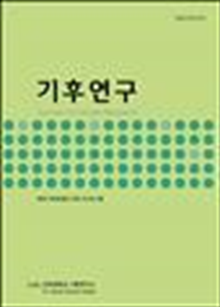간행물
기후연구 KCI 등재 Journal of Climate Research

- 발행기관 건국대학교 기후연구소
- 자료유형 학술지
- 간기 계간
- ISSN 1975-6151 (Print)2288-8772 (Online)
- 수록기간 2006 ~ 2021
- 주제분류 사회과학 > 지리학 사회과학 분류의 다른 간행물
- 십진분류KDC 453DDC 551
권호리스트/논문검색
제14권 제4호 (2019년 12월) 5건
수도권 여름철 집중호우 장기변동성
1.
2019.12
서비스 종료(열람 제한)
The long-term variability of summer heavy rainfall in the Seoul metropolitan area was investigated in this study for the period of 1970-2018. The study period was divided into two phases; first phase from 1970 to 1994 and the second phase was 1995 to 2018. Long-term variability of summer heavy rainfall was examined using the change-point analysis method. Annual mean heavy rainfall amounts showed increasing trends in Seoul and Incheon during summer monsoon season (June to August). Results revealed that the changes in frequency and amount of heavy rainfall were observed larger in the months of July and August as compare to June during the second phase. The upper-level trough was prominently developed at the west of the Seoul metropolitan area and the core region of the upper-level jet was shifted to the east of the area during second phase. The western North Pacific subtropical high was expanded westward and moisture flux flowed along the southwesterly wind, resultant increasing moisture supply. The temperature and humidity tended to increase recently at the lower and mid-levels.
2.
2019.12
서비스 종료(열람 제한)
The detailed characteristics of fog over South Korea were analyzed using the three-years quality controlled (QC) 237 visibility meter data operated by Korea Meteorological Administration. The fog (dense fog: DFog) frequency varies greatly with season and geographic location. The fog frequency at inland is highest in autumn, but at the West Coast in spring and summer. Fog occurs frequently from spring to autumn in the mountainous regions. Unlike the fog, the DFog is mostly prevalent in summer at land, mountain, and coastal regions. The large coefficients of variation of fog and DFog at the three regions and four seasons indicate that the locality of fog over South Korea is very high. The formation and dissipation (FaD) of fog show strong diurnal variations irrespective of geographic location and season, strongest at inland and weakest at sea. Fog usually occurs from night to sunrise and dissipates from early morning to late morning. The maximum FaD time of fog show seasonal variation with the seasonal change in solar elevation angle. The frequency of fog is inversely proportional to the duration time, mostly less than 3 hours regardless of season and geographic location. Also, the duration of DFog is mostly within 1-3 hours.
3.
2019.12
서비스 종료(열람 제한)
This study had two main objectives. We first investigated which weather phenomena people were most concerned about in the context of climate change or global warming. Then, we conducted content analysis to find which words were more commonly used with climate change or global warming. For this, we collected web data from Twitter, Naver, and Daum from April to October 2019 in the Republic of Korea. The results suggested that people were more concerned about air quality, followed by typhoons and heat waves. Because this study only considered one warm period in the year of 2019, winter-related weather phenomena such as cold wave and snowfall were not well captured. From Twitter, we were able to find wider range of terminologies and thoughts/opinions than Naver and Daum. Also, more life-relevant weather events such as typhoons and heat waves in Twitter were commonly mentioned compared to Naver and Daum. On the other hand, the comments from Naver and Daum showed relatively narrower and limited terms and thoughts/ opinions. Especially, most of the comments were influenced by headlines of articles. We found many comments about air quality and energy/economic policy. We hope this paper could provide background information about how to promote the climate change education and public awareness and how to efficiently interact with general audiences.
4.
2019.12
서비스 종료(열람 제한)
In this study, we produced grid climate data sets of 1km×1km and 5km×5km horizontal resolutions based on MK (Modified Korean)-PRISM (Parameter-elevation Regressions on Independent Slopes Model), a statistical downscaling method that can estimate grid data of horizontal high-resolution using observational station data in Korea. To compare the MK-PRISM performance according to resolution, RMSEs of 1km resolution data and 5km resolution data were calculated and analyzed. The RMSEs of the two data sets were similar, but the results classified according to the elevation were different. The 1km high resolution estimated data was shown to better reflect the impact of the terrain for the daily mean temperature and daily maximum temperature, whereas the difference between the two data sets for daily minimum temperature was not statistically significant at each elevation. Furthermore, we also divided the temperature data into 9-classes based on the observed temperatures, and then compared the estimated performance of the two data sets according to elevation. For the low temperature group, performance of the 1km resolution data at high elevations outperformed that of the 5km resolution data, regardless of the season.
5.
2019.12
서비스 종료(열람 제한)
The purpose of this study is to develop a method to assess the expected damage and loss of vehicle by flood disaster. To this end, we designed the inventory (exposure) DB to define spatial location and distribution by vehicle type, and presented the construction procedure of inventory DB. Vehicle asset value required for quantifying loss was taken into account depreciation in the replacement cost of each representative vehicles. The vehicle vulnerability curve is used to analyze the percent damage due to flood depth. It is classified the vehicle into three types based on the vehicle height, developed the vulnerability curve from the opinion of the expert group. The method proposed in this study is part of f lood loss assessment model. It will be used for flood risk assessment and economic analysis of flood mitigation projects.

